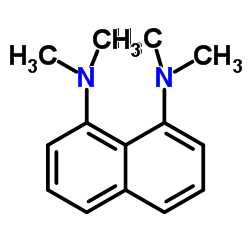1,8-bis(dimethylamino)naphthalene

1,8-bis(dimethylamino)naphthalene structure
|
Common Name | 1,8-bis(dimethylamino)naphthalene | ||
|---|---|---|---|---|
| CAS Number | 20734-58-1 | Molecular Weight | 214.306 | |
| Density | 1.1±0.1 g/cm3 | Boiling Point | 304.4±22.0 °C at 760 mmHg | |
| Molecular Formula | C14H18N2 | Melting Point | 49-51 °C(lit.) | |
| MSDS | Chinese USA | Flash Point | 128.3±10.2 °C | |
| Symbol |

GHS07 |
Signal Word | Warning | |
|
In situ characterizing membrane lipid phenotype of breast cancer cells using mass spectrometry profiling.
Sci. Rep. 5 , 11298, (2015) Lipid composition in cell membrane is closely associated with cell characteristics. Here, matrix-assisted laser desorption/ionization- Fourier transform ion cyclotron resonance mass spectrometry was employed to in situ determine membrane components of human m... |
|
|
Distribution study of atorvastatin and its metabolites in rat tissues using combined information from UHPLC/MS and MALDI-Orbitrap-MS imaging.
Anal. Bioanal. Chem 406(19) , 4601-10, (2014) The combination of ultrahigh-resolution mass spectrometry imaging (UHRMSI) and ultrahigh-performance liquid chromatography coupled with tandem mass spectrometry (UHPLC/MS/MS) was used for the identification and the spatial localization of atorvastatin (AT) an... |
|
|
Proton sponge: a novel and versatile MALDI matrix for the analysis of metabolites using mass spectrometry.
Anal. Chem. 81 , 7954-7959, (2009) Here, we show the usefulness of a strong base, 1,8-bis(dimethyl-amino)naphthalene (DMAN; proton sponge), as a novel matrix for MALDI-TOF/MS analysis of anions. Several strong and weakly acidic low-molecular-weight analytes (fatty acids, amino acids, fatty aci... |
|
|
Lipid fingerprinting of gram-positive lactobacilli by intact--matrix-assisted laser desorption/ionization mass spectrometry using a proton sponge based matrix.
Rapid Commun. Mass Spectrom. 25 , 1757-1764, (2011) A method of direct lipid analysis by matrix-assisted laser desorption/ionization (MALDI) mass spectrometry (MS) in intact membranes, without prior extraction/separation steps, is described. Here, we demonstrate the efficacy of a strong base, 1,8-bis(dimethyla... |
|
|
1,8-Bis(dimethylamino)naphthalene: a novel superbasic matrix for matrix-assisted laser desorption/ionization time-of-flight mass spectrometric analysis of fatty acids.
Rapid Commun. Mass Spectrom. 23 , 2380-2382, (2009)
|
|
|
Synthesis of C-substituted t-BuNH-8,9-R,R'-nido-7,8,9-C3B8H9 (R,R' = H,H; MeH; Me,Me; Ph,H and Ph,Ph) tricarbollide compounds and their tautomeric conversions. Effect of substituents on tautomeric equilibria between neutral and zwitterionic forms.
Dalton Trans. 39(17) , 4186-90, (2010) Treatment of C-substituted nido dicarbadecaboranes 5,6-R',R-5,6-C(2)B(8)H(10) (1) (where R',R = H,H (1a); H,Me, (1b); Me,Me, (1c); H,Ph, (1d) and Ph,Ph, (1e) with 1,8-bis-(dimethylamino)naphthalene (proton sponge = PS) and t-BuNC in CH(2)Cl(2), followed by ac... |
|
|
Carbon insertion into arachno-6,9-C2B8H14 via acyl chlorides. skeletal alkylcarbonation (SAC) reactions: a new route for tricarbollides.
Inorg. Chem. 52(15) , 9087-93, (2013) Reactions between arachno-6,9-C2B8H14 (1) and selected acyl chlorides, RCOCl, in the presence of PS (PS = "proton sponge", 1,8-dimethylamino naphthalene) in CH2Cl2 for 24 h at reflux, followed by in situ acidification with concentrated H2SO4 at 0 °C, generate... |
|
|
Magnetic superbasic proton sponges are readily removed and permit direct product isolation.
J. Org. Chem. 79(22) , 10908-15, (2014) Workup in organic synthesis can be very time-consuming, particularly when using reagents with both a solubility similar to that of the desired products and a tendency not to crystallize. In this respect, reactions involving organic bases would strongly benefi... |
|
|
R.W. Alder et al.
J. Chem. Soc. Chem. Commun. , 723, (1968)
|
|
|
R.L. Benoit et al.
Can. J. Chem. 65 , 996, (1987)
|